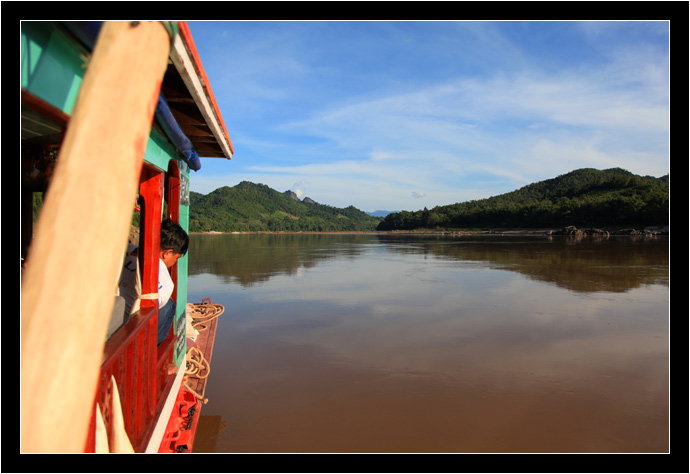
I’ll admit that I knew hardly anything about Laos before entering the country. Our friend, Wendy, did the initial planning for the trip – she was the one that picked the border crossing so we could take a two-day trip down the Mekong River (which was half awesome and half horrible and the latter was not her fault.)
Going into a country without knowing much about it is a lot like watching a movie without seeing the trailer first. Knowing what you’re in for doesn’t necessarily mean you’ll enjoy it any more or less. I’m happy to say I enjoyed our time in Laos and, even though we were only there eight days, I learned a lot more about the country that I thought I would.
Pronunciation
Okay, first off, it’s “Lao” not “Laos.” The French added the ‘s’ during their Indochina occupation and it’s silent besides.
The people are Lao, the country is Lao. Technically, Laotians call their country “Muang Lao,” or “Pathet Lao,” both of which translate to “Lao Country.” When the French came along, they united three separate Lao kingdoms and so it sort of made sense (in their language) to pluralize the name of the new territory.
Thanks, Wikipedia!
Language
As I mentioned when I wrote about Thailand, at least one part of Laos speaks a language very similar to the Northern Thai dialect. Honestly, if they can speak across the border with 90% understanding, you can bet I wasn’t going to be able to pick out the differences. Seemed exactly the same to me.
Although… come to think of it, I did notice some spelling differences. Take the Thai word for city: Chiang. We encountered it all the time in Thailand. Chiang Mai, Chiang Rai, Chiang Khong. It took me a too long to realize that in Laos, “Xiang” meant the same thing.
In fact, there seem to be a lot more ‘X’s in Laotian place names. I’m guessing that’s an indication of a heavy Chinese influence. Interesting that, even though “Chiang” and “Xiang” are pronounced quite similarly, the difference is great enough to penetrate their English-language spellings.
The written language in Laos is, I believe, different than that of Thailand. I could be wrong. Both just look like a bunch of swirls to me.
Conservative Culture
Laos is up front about their people’s conservative nature. Even at a small border crossing in Northern Thailand, there were posters printed up and taped to the immigration office’s concrete pillars. I wish I’d taken photos of them.
Other than the expected “drug use is illegal,” as well as the unexpected “women can’t touch monks,” I remember taking note of two things that could conceivably have been a cause for concern. The first was in relation to appropriate dress and basically came down to “don’t show a lot of skin,” though it stood out to me because it showed a foreigner going for a swim in his swim trunks. There are waterfall tours, so I could see doing that. The second had to do with personal displays of affection. While not illegal, it is extremely rude to kiss or hug in public.
Furthermore, I learned that it was illegal for a foreigner to have sexual relations – or even to stay in the same room – with a Laotian. The penalties for getting caught could include jail terms and stiff fines, but in reality of a quick police shakedown is more likely. We heard stories of Laotian girls picking up tourists at a bar, going back to his hotel, and then texting a contact once inside. A few minutes later, the police are barging in, handing collecting “fines” from both the tourist and the hotel proprietor.
While their conservatism cuts down on the rampant sex tourism that neighboring Thailand has become known for, denying sexual relations between Laotians and foreigners, on the surface, seems like blatant racism to me. That, and the fact that Laos had the only immigration form in all our travels that asked us to list our race, makes the country appear quite intolerant.
Now, that said, while people in Laos seemed a little less forthcoming with their smiles than people in Thailand, I found them no less friendly.
Before we move on, a word about those posters at customs:
I noticed them posted at other tourist-centric places, too, like the Plain of Jars in Phonsavanh. At first glance, each poster looked like a 6-panel comic strip. It was only after reading the captions that you would realize these were “Do Not” posters. Do not climb on the Jars. Do not litter. Do not leave the trail.
In every one, a clueless tourist – obvious from his or her pale skin and skimpy attire – would be engaged in some egregious behavior. But here’s the interesting part: Unlike most other “Do Not” signs, there were no red slashes through the image instructing you not to do what the tourist was doing. I didn’t think much of it at first – there were, after all, English captions beneath each frame that explained the rules being illustrated. But on the Plain of Jars poster, the last frame was labeled “Support community based tourism to protect the Plain of Jars by buying local products and services.” Hey, that’s not a “Do Not!” That’s a “Do!”
Looking back over all the cartoons in the series, I realized I’d missed something subtle before. Instead of using a red slash, each cartoon had a local showing shock and dismay at the behavior of the tourist. Except in the last frame. There, all the locals were all drawn smiling at the (still clueless) tourist as he purchased some fine local products and services…
To me, compared to a big red diagonal line, it was a subtle message, but knowing what I know now about Laotian culture, I can see that the shock drawn on the cartoon locals’ faces was just as blatant, for them, as a big red slash is for us.
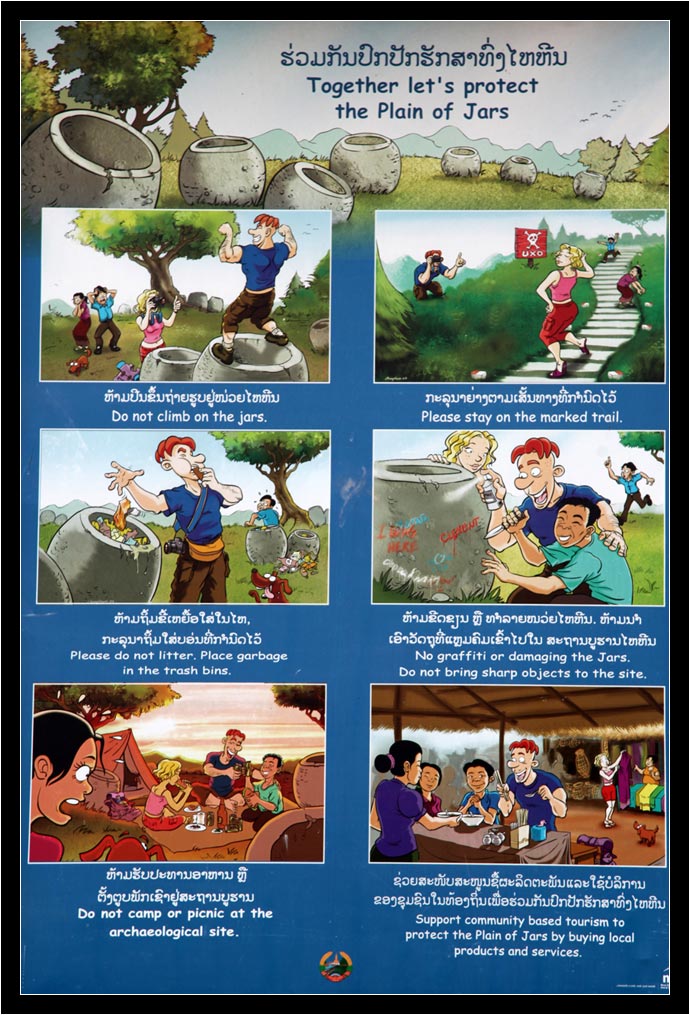
Saving Face
Saving face is a difficult concept to distill down to just a single sentence. It’s a little bit like honor, a little bit of not rocking the boat, it’s a tacit approval of little white lies. As a Westerner, it’s incredibly hard to wrap your mind around the scope of saving face, because it extends to every single social interaction you can have.
An example we heard from an Australian guy who opened a pub in Luang Prabang:
He has some electrical work that needs to be done, so he asks his Laotian employees if they know anyone with the appropriate trade skills. One of them recommends his friend or family member. The owner interviews the guy, asks him if he’s worked with wiring before. He says he has, plenty of times. So he hires him and, on the first day, the owner watches over his shoulder as he gets started. Within minutes he realizes the guy has literally no idea what he’s doing. If he lets him continue, there’s a very good chance he’ll be electrocuted. The owner confronts the guy, starts arguing with him in front of his other employees. “Why did you tell me you knew what you were doing?” The Laotian guy starts to cry…
If I were to try to define it in one sentence: “Saving face is doing everything possible to avoid a situation in which someone else may become embarrassed.”
In the case of the Australian pub owner, he embarrassed both the new guy and his other employees (or at least the one that recommended the new guy.) A Laotian boss would have handled the situation very differently. He may have said something like, “You know what? I just realized that this project does not need to be done right. Why don’t you go home and I’ll let you know when I’m ready.” Of course, he’d never call him back – everyone involved would know he wouldn’t call him back – but at least the guy wouldn’t leave embarrassed.
In our time in Laos, I can only think of two situations in which we ran up against the saving face thing. (Well, two situations where we were aware of it, anyway.)
The first was harmless enough. Often people in hostels and such would tell us that the prices were higher because we were visiting during the high season. We knew that to be one of those little white lies and told them so. As soon as we let on that we were better informed than the average tourist, they would give a tiny smile and begin to negotiate the price downward.
The second was more disgusting. Picture this: We’re crammed into a minivan, shoulder-to-shoulder with 11 other tourists and one local, on the way from Luang Prabang to Phonsavanh. Between the two towns is nothing but twisting mountain roads and our driver is dead set on getting to Phonsavanh as quickly as possible. It’s like a roller coaster, only more dangerous. We’re rocking side-to-side, looking over the edge of guardrail-less roads, for hours on end.
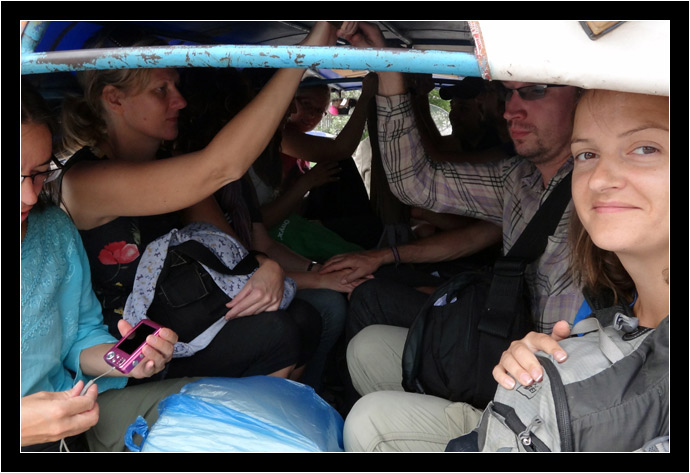
At one point, I smelled Thai food. I didn’t realize it at the time, but the local guy in the very back seat got motion sick and, well, juggled his cashew chicken, if you know what I mean.
The reason I didn’t realize he had tossed his cookies was because he didn’t say anything about it. He just leaned over, puked half on his lap and half down between the seat and the side panel. Didn’t ask to stop, didn’t attempt to clean it up. I’m 99% sure he was thinking, “If I pretend that didn’t happen, maybe everyone else will, too.”
Except that, no, it did happen and now we’re driving a vomit-comet though the mountains. At the next stop, the Italian couple sitting next to him tried to convince him to clean himself up. He just smiled and pretended the language barrier was the reason he couldn’t understand them.
The rest of us started leaning on the driver, since he spoke some English. When he realized what had happened, he laughed. “Not my problem!” He actually said that.
Because the Italians weren’t actually doing anything and the Laotian guy was still diligently pretending it hadn’t happened at all, Oksana was the one that finally got fed up and got out of the van. She opened up the rear hatchback and discovered that one of the German tourist’s backpacks had caught a piece of the Laotian’s stomach contents. While they cleaned that up, Oksana bullied the driver into finding her some clean water and rags (he literally pulled someone’s clothes off a clothesline where they were drying!) Other tourists passed back some wet wipes and plastic bags for the cleanup. Oksana, complaining loudly the whole time, managed to splash or wipe away the worst of the mess.
Of course, once we were back on the road, the Laotian guy let loose again. This time, however, we had him loaded up with plastic bags and sat him near an open window. Unfortunately, he was sitting next to the German girl and the sights and sounds and smells were too much for her. She lost her groceries a couple times, too.
Fun ride.
Motion Sickness
I wish I could tell you that was an isolated incident. It’s probably safe to say that someone upchucked on every bus ride we took through Laos, Vietnam, and Cambodia. The only reason I can’t say for sure is because I tried my best not to find out.
Seriously, what’s up with Southeast Asians and motion sickness? Our experiences, combined with anecdotal evidence from other tourists, seem to indicate a huge problem. What could possibly be going on? Is it a question of “nature vs nurture?”
Could it be that, as children, very few Southeast Asians get accustomed to riding in automobiles, and therefore never develop a learned immunity to motion sickness? We certainly get our practice in the States’ car culture. The vast majority of us are in car seats before we’re a year old (whereas they’re much more likely to have ridden on a scooter!) I could see a case being made that “X amount of hours spent in a car before your Y birthday can have a significant impact on your susceptibility to motion sickness.”
Or is it possible that there’s a physiological difference? Do Southeast Asians have some sort of genetically-inherited inner ear problem? A stronger gag reflex? Collapsible stomachs?
More importantly, if they know they’re susceptible to motion sickness, why the hell do they eat huge lunches at the rest stops, sit next to windows that don’t open, and not have the foresight to have a convenient bag at hand? Those are the questions I really want answered!
Oh, that’s right. Can’t ask. Saving face.
Transportation and the Postal Service
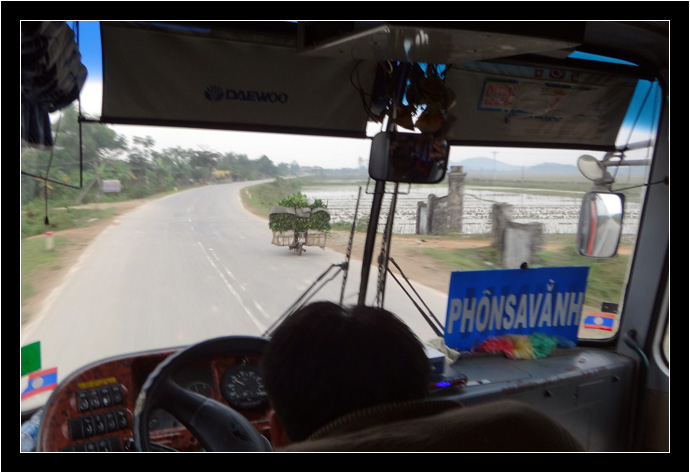
We only took one bus ride while we were in Laos, from Phonsavanh to Vinh, in Vietnam. The rest of our traveling was done by boat or minivan. I mention that, because I’m not sure what I saw on this particular bus ride can be considered normal.
We climbed aboard fairly early and the bus departed around 6:30 or 7 in the morning. Oksana and I sat up front, right behind the driver, so we saw everyone that came on or got off the bus. The first thing we noticed was a well-dressed woman sitting next to us. She had a huge stack of U.S. currency in her hand and an office furniture catalog in the other. No idea what that was about; maybe she was picking things up in Vietnam that are hard to find in Laos.
It took us a good hour and a half to get out of Phonsavanh, which would make you laugh if you knew how small the town really is. We drove all over the place, picking people up, dropping kids off at school, things like that. A teenager with an AK47 slung over his shoulder hopped on and casually sat down in the back. He smiled and waved to people he knew; no one batted an eye. Same with the woman that brought her caged songbird.
After awhile, we speculated that the bus was actually being used as a postal delivery vehicle. Not only were people constantly getting on and off, but the storage compartments underneath the bus (where our backpacks were stowed) were being opened and closed at every stop. Thankfully, all that ended once we reached the outskirts of town.
Tractors
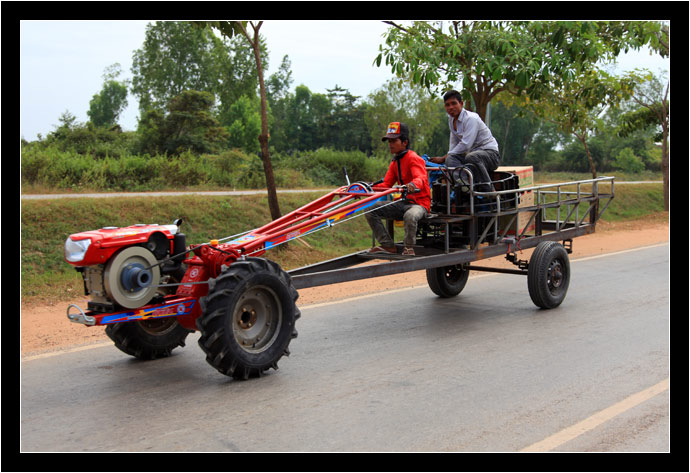
I don’t know what to call these things, but we saw them all over the place. They’re basically tractor engines balanced on two wheels. Handlebars – for lack of a better term – reach a long way back to where the operator sits. They look, for all the world, like a two-wheeled tractor or perhaps a riding lawn mower cut in half.
At first, I couldn’t tell what they were really for. Most every one I saw was on the street, hitched up to a makeshift wagon or trailer. People were using them as actual tractors (albeit ones you steered from 10 feet back), just not in the fields.
It wasn’t until I passed a showroom full of new ones that I started to get an idea of how they were meant to be used. The wheels on the showroom models weren’t rubber at all, they were more like big, plastic paddlewheels. Rice paddies, that’s my guess.
I know next to nothing about rice cultivation or harvesting, but when I pictured a guy standing behind one of those two-wheeled tractors with the long handlebars in his grip, it reminded me of the way they used to stand behind a water buffalo yoked to a plow.
Used to? Or still do? We saw plenty of that action later in Vietnam.
Weather
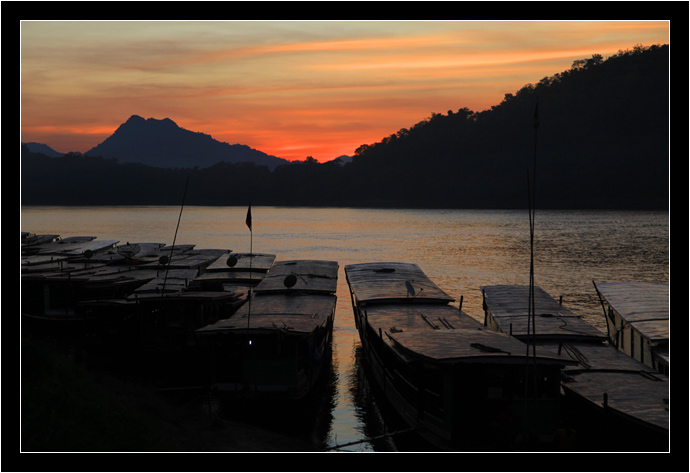
We weren’t in Laos long enough to really get a feel for the weather, but most days were hot, hazy, and humid. It rained on occasion, but you could go most days without spotting a single cloud in the sky.
The haziness, while making for some great sunsets, puzzled me. Where did it come from? Was it simply humidity (doubtful), or could it have been smoke from some monstrous fire? Could the rumored pollution from the large cities in Vietnam and China possible reach as far as Luang Prabang? Wish I knew.
Economy
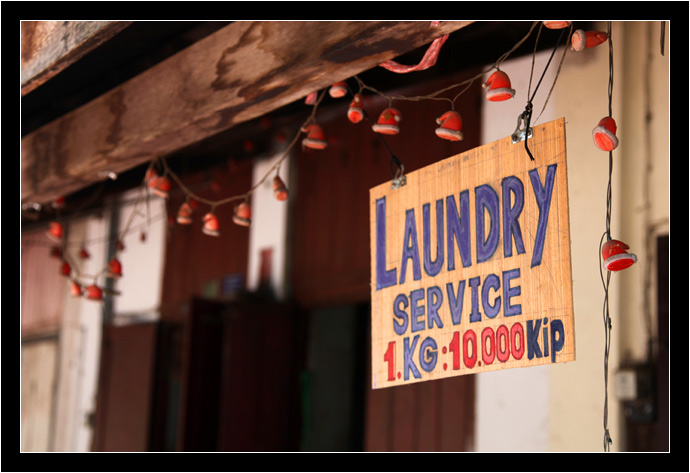
The Laotian economy, while steadily improving, is still decidedly that of a developing nation. If I remember correctly, we were getting about 8,000 kip to the dollar.
Because it’s such an unimportant currency on the international market, it’s not easy to get kip anywhere other than in Laos or along its borders. Leaving the country with a lot of local currency in your pocket is a great way to have a lot of local currency for a souvenir – it’s not easy to exchange it back into dollars.
I noticed that high ticket items in Laos always had their prices in Thai baht. Makes sense that they wouldn’t want to lose out to the exchange rate when selling cameras, memory cards, and other such things.
The people of Laos must have been dealing with this for a long time. Everyone that handled money could quickly do the conversions between kip, Thai baht, and U.S. dollars on the fly. And not just one to the other, either. You could pay in dollars and they could hand you back mixed change, say 50 baht and 2500 kip, without even thinking about it.
No idea how they keep on top of the daily exchange rate, though!
Pharmacies
Or lack thereof.
We didn’t go out looking for a pharmacy or anything – we weren’t sick while we were in Laos. I bring them up because they were notable by their absence. Oksana and I had become so used to seeing pharmacies on every other corner, in every other country, that we found it surprising it’s not the same in Laos.
I do know that the life expectancy in Laos isn’t that high… could it be because they don’t have access to proven medications? Maybe. Missing pharmacies could just mean that they use a different system. Maybe people get their over-the-counter and prescription medication straight from the doctor’s office, clinic, or hospital.
Bread
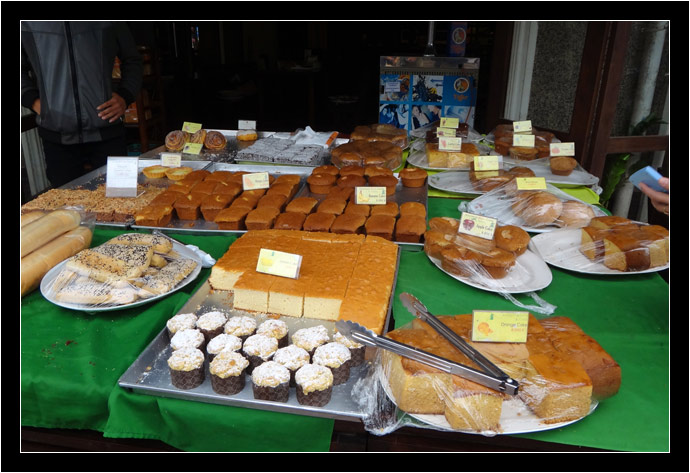
After Thailand, where we couldn’t find a bakery to save our lives, Laos’ baked goods were a delight. We noticed bakeries in the first small towns we visited along the Mekong River, but it wasn’t until we reached Luang Prabang that I started going crazy for bread.
There was a touristy café along the main street in town that we would stop in every morning. They would have a table set up on the sidewalk and it was always filled with tiny loaves of bread. Banana bread, orange bread, coconut, mango, chocolate, apple, cinnamon. I experimented a bit, but always came back to banana bread. It was so good and the little loaves were just big enough to make a decent breakfast.
Better still, any unsold loaves would go on sale in the evening at the night market. Every night, I made a point to stop by and pick up some bread to go.
I wasn’t in the country long enough to really get a handle on Laotian cuisine, but it seemed to me that it wasn’t altogether different from Thailand’s or Vietnam’s. The bread stood out, though. I wonder if that’s a holdover from the French occupation, too.
Bathrooms
For the life of me, I can’t imagine why we haven’t seen this before in our travels: In Laos, the toilet paper holders have closable plastic covers! Why? Well, because most of the hostel bathrooms still have those faucets-built-right-into-the-wall style showers. Without a shower curtain, water gets all over the tile bathroom and you’re shit-out-of-luck (literally) if you forget to put your toilet paper somewhere high and dry.
Not so in Laos! The toilet paper always stays nice and dry when it’s housed in that little plastic container.
Generally speaking, the toilets in all the private bathrooms we encountered were “normal” in Laos, too. That is to say, they weren’t squat-type toilets. One weird thing was that there was a small bucket with a handle on it, sort of like a giant ladle, near every toilet.
We didn’t realize what they were for until we saw something similar in the public restrooms. It seems that flush plumbing is more a luxury than a staple and, even though there may be a toilet in the restroom, it may not be hooked up to a running water supply. In that case, there would often be a huge barrel – or sometimes a chest-high, cement box built into the wall! – full of clean water inside the bathroom. Floating on top of these cisterns would be a little plastic bucket. That’s your flush.
Seemed strange to me. Most times they had a faucet directly above the barrels so that it could easily be refilled. If you’ve already got plumbing to the faucet… why not hook it up to the toilet?
Curfew
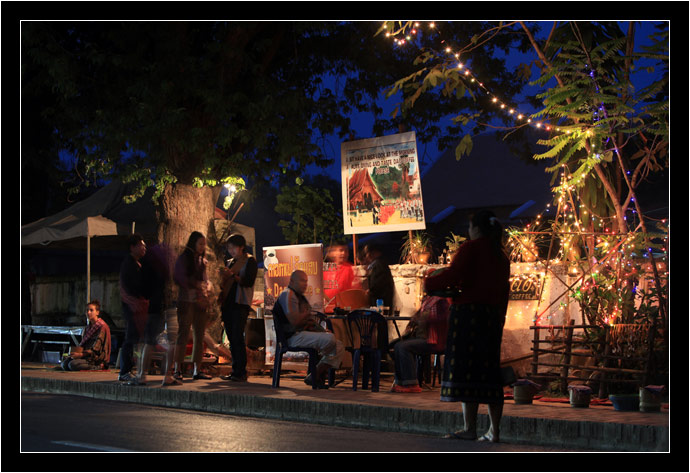
Laos has a curfew; the entire country closes down at midnight. I don’t know if it’s legally a curfew – as in a “you’ll be arrested for being out on the street after midnight” curfew – or just a law that says everything (restaurants, bars, etc.) has to close down at 11:30pm. Whatever the case, it seems pretty strict and makes for some quiet nights.
Realistically, this didn’t affect us very much. We’re not into the clubbing scene, and besides, we tried to get up super early to see the alms ceremony in Luang Prabang. I was under the impression that there was at least one bar (and a bowling alley!) just outside the city limits where tourists could go to get their Gremlin on.

Don’t feed ‘em after midnight? Gremlins? See where I was going with that? Nevermind.
Most, if not all, of the hotels and hostels respect the curfew, whether it’s an actual law or not. There were many signs letting you know that the doors or gates would be locked promptly at midnight. I’m quite sure that since the 1990s, when Laos was opened up to tourism, that hostel workers have been learning firsthand what a curfew means to a drunken backpacker. It means that their key is replaced by loud knocking and shouting, that’s all.
The Secret War
Everyone knows about America and its Vietnam War. Not everyone knows that America also attacked Laos. Officially, Laos was considered a neutral country and both Vietnam and the United States of America were going against the Geneva Conference of 1954 by conducting their warfare within its borders.
From the mid-60s to the mid-70s, the North Vietnamese used the eastern part of Laos to bypass the front lines of combat (the demilitarized zone.) They would move soldiers and machinery down the Ho Chi Minh Trail, through Laos, to stage military actions against South Vietnam. In an effort to prevent this, the United States Air Force bombed the shit out of Laos.
The numbers boggle the mind. 260 million bombs, 2 million tons of ammunition. It was estimated that, on average, a bomb was dropped on Laos every eight minutes, 24 hours a day, for nine years. The U.S. used more ordnance on Laos in that decade than the all the ordnance dropped during World War II combined.

Up to 30% of that ordnance – roughly 80 million bombs – failed to explode on impact. They’re still going off today. Since the war officially ended, there have been an estimated 12,000 casualties from Unexploded Ordnance (UXOs.) In 2006 alone, 59 people (and who knows how many livestock) were injured or killed by weapons that were used in a war 30 years gone. 1
I can’t imagine what it must be like to grow up in a country with such dangers. We visited a site called the Plain of Jars and the safety information scared the hell out of me. At the entrance to the park was a sign that showed how colored concrete markers – red on the outside, white on the inside – were used on the trails throughout the park:
White: indicates areas where sub-surface UXO clearance has occurred
Red: Indicates areas where UXO has only been removed from the surface
YOU ARE ADVISED TO STAY BETWEEN THE WHITE MARKERS

Another sign explained the extent to which the site had been readied for tourists. The highlights were:
Clearance Statistics
- Area Sub-surface Cleared: 24,375 sqm
- Area Visually Searched: 225,000 sqm
- Vegetation Cut: 218,328 sqm
- UXOs Found / Destroyed: 127
- Scrap found: 31,814 pieces
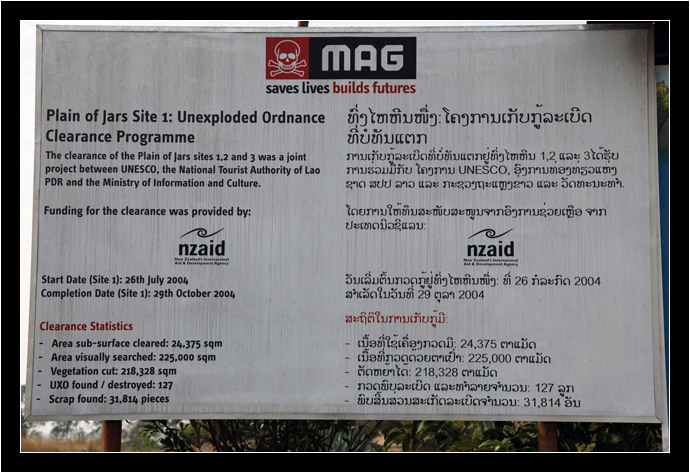
You know what that tells me? That tells me that 200,625 square meters – over 2 million square feet or roughly 50 acres – could still have unexploded ordinance just below the surface! As we walked through the park, always heeding the ALL CAPS suggestion to STAY BETWEEN THE WHITE MARKERS, we observed numerous craters, each about 20 feet across by a dozen feet or so deep. Sobering reminders of what the countryside (not to mention this ancient and unique burial site) endured not-so-long ago.
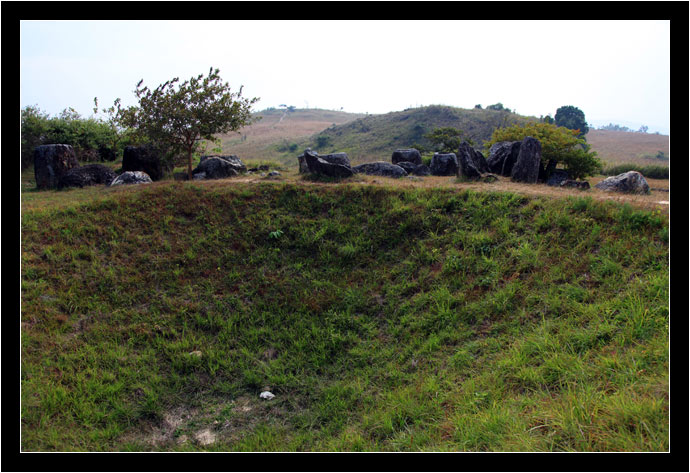
I kid you not, this actually happened: While we were standing on the top of a hill, discussing how such an impoverished country could deal with a legacy like this, we heard a big rolling boom from across the countryside that went on to echo off the hills. Just a car backfiring? Or maybe a cow stepped in the wrong place just became hamburger. Maybe it was someone’s child.
How the hell do parents raise their kids in an environment like that? Do they teach them to fear stepping off a trusted path in the same way we raise our kids to look both ways before crossing the street?
God, it’s depressing.

You must be logged in to post a comment.